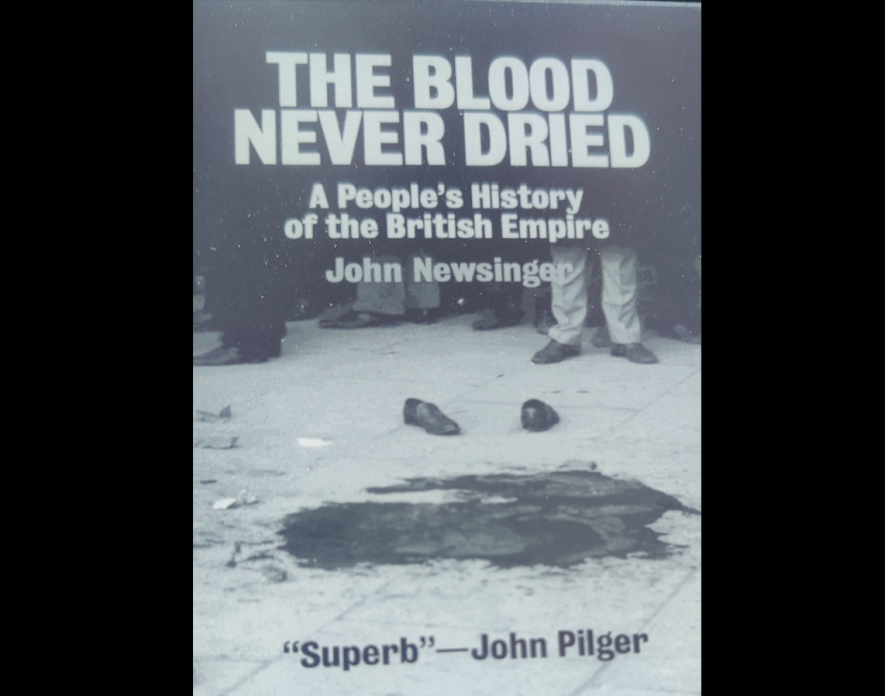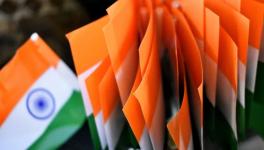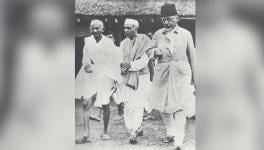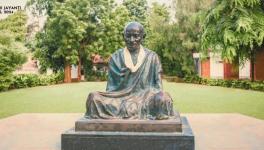Queen Elizabeth: A Book That Objectively Looks at British Colonial History

The way media is eulogising Queen Elizabeth on her death after living four years short of a century by way of showing her as benign, kind and what not, is just a cover-up for two hundred plus years of brutal colonial past of UK or Britain or England.
It is true that a Queen or King is not directly or personally responsible for the cruelties and brutalities done by way of laws passed through the UK Parliament, but it goes in the name of the King or Queen, whether it was King George V and VI in India or Queen Elizabeth in Kenya, ironically where she was declared Queen of the Empire after the worst brutalities of colonial Britain took place. There was not a word of sympathy or disapproval from her.
One cannot undo the past, yet one has to remember it. It is necessary to look at history and individuals in an objective manner and that is what British scholar John Newsinger had done in his path-breaking book --The Blood Never Dried. The column, Relook At a Book, is being replugged in Newsclick in the wake of the defence of the British colonial period in a romanticised way in the name of Queen Elizabeth!
Earnest Jones, the British socialist poet, wrote in his long poem The Revolt of Hindostan, “On its colonies, the sun never sets, but the blood never dries.”
John Newsinger, a British historian with left orientation, titled his book published in 2006 The Blood Never Dried: A People’s History of British Empire’. Its second and updated edition, which came out in 2013, is dedicated to the writer’s old comrades from Leicester—Chris Lymn, Mal Deakin, Andy Wynne, Jim Tolton, John Peach and the late Ken Orrill.
The book covers the history of British colonial oppression and exploitation in different regions of the world as Britain had colonised nearly a hundred countries in Asia, Africa and some other regions. The author’s main focus is not on many countries but on the major freedom struggles and the cruelties British committed to crush those anti-colonial movements.
The Indian resistance figures twice in the book—first, as ‘The Great Indian Rebellion, 1857-58’ and then as ‘Quit India’ movement. In between, another chapter refers to massacres like the Jallianwala Bagh. The first chapter of the book begins with ‘The Jamaican Rebellion and the overthrow of slavery’.
There are chapters on Ireland, Irish famine, Opium Wars, Egypt, Suez Canal, Palestine Question, Mau Mau Movement in Kenya, Malaya and the Far East. Finally, the British colonial empire gives up before the neo-colonial regime of the American empire begins.
In the 2013 edition, a chapter on the US invasion of Iraq takes readers to the reality of the merging of colonial and neo-colonial systems of oppression and exploitation of the world’s largest population and how the fruits of this exploitation are enjoyed by a minuscule number of colonial and neo-colonial rulers and their patronised corporate giants—which, perhaps, has grown much worse during the pandemic.
In the introduction to the first edition of the book, Newsinger underlines the fact that “a close look at British imperial rule reveals episodes as brutal and shameful as in the history of any empire, indeed the British colonial regime suppressed the Mau Mau rebellion in Kenya in the 1950s.” We remember the Jallianwala Bagh massacre in Amritsar on April 13, 1919. But if one compares it with the British suppression of the Mau Mau rebellion around three decades later in Kenya, the Jallianwala Bagh brutality looks much lesser. What makes it gorier was that the atrocities were committed after the formation of international organisations like the United Nations.
The author refers to the previously hidden 294 boxes of 1,500 files on the Mau Mau rebellion, whose judgement came after the 2013 edition of the book. Britain had to pay a huge compensation of £19.9 million to the descendants of the 5,000 Kenyan victims. Whereas in the Jallianwala Bagh massacre, the British had to pay a few lakh rupees to the families of the victims and only Rs 500 to some.
Referring to author N Ferguson, an apologist of British imperialism whose book Empire: How Britain Made the Modern World (2003) doesn’t even mention the Mau Mau revolt, Newsinger writes: “The Mau Mau revolt of the 1950’s was put down with terrible brutality, the routine use of torture, the summary executions, internment on a massive scale and the hanging of over 1000 prisoners.”
Newsinger not only narrates the history of oppression and brutalities of British colonialism but also goes to the roots of exploitation. “Imperialism has two dimensions; firstly, the competition between the great imperial powers, competition that in the 20th century produced two world wars and the Cold war. This competition is the driving force of modern imperialism, and it has wreaked terrible damage on the world, consuming millions of lives.”
Probably, one can understand the Ukraine War and the resulting Cold War-like situation from Newsinger’s interpretation of imperial competition. In his introduction, the author refers to a few films on the repression of South African people but also underlines the role of radicals and socialists in Britain who supported the resistance movements in colonies. He underlines the stand against British imperialism in Jones and another fierce critic of the empire, radical socialist William Morris.
In this context, the author does not spare the so-called progressive Labour Party, which was no different from the Conservatives in defending the colonial empire. Newsinger is unsparing of the new Labour Party with the rise of Tony Blair, who played a subordinate to US imperialism. The author has the humility to say that his study is not the history of the British colonial empire but only focuses on particular episodes—but these episodes expose the real and brutal face of old colonialism and neo-imperialism.
In the 2013 edition, like the first edition, Newsinger challenges another apologist of colonial empires John Darwin, a professor of history at Oxford University. In critical scrutiny of his 400-plus pages-book Unfinished Empire: The Global Expansion of Britain (2012), he questions how Darwin casually referred to the catastrophic Bengal Famine of 1943. Darwin just gives a passing reference on page 346 that “the Bengal Famine of 1943 may have killed two million people”.
Newsinger favourably refers to Madhusree Mukherjee’s book Churchill’s Secret War’, which powerfully exposes the British colonial regime during the famine. As per Mukherjee, the famine killed 3.5 to 5 million people while Winston Churchill used to say, “Indians are used to hunger.”
This edition also takes into account the British role in the Iraq and Afghanistan wars. A new chapter on Iraq and Afghanistan has been added. The first chapter on Jamaica takes us back to the days of slavery and in Antigua, where less than 3,000 Whites were holding more than 24,000 Blacks as slaves.
The British empire in the Caribbean was built on the production of sugar from plantations where Africans worked as slaves and later Indians as semi-slaves after the abolition of slavery. In Jamaica, five lakh slaves were brought in from Africa between 1700 and 1774. During the 180 years of British rule in Jamaica, hardly any decade went without revolt against slavery. In neighbouring Trinidad, Barbados and Guyana, the situation was no different. Slaves were brought in chains and sold like cattle in markets. After the killing of thousands of people and several revolts, slavery finally ended in 1834.
The second chapter ‘The Irish Famine’ is a saga of the Irish revolutionary resistance to the British empire, which also inspired Bhagat Singh and other revolutionaries in India. The story begins with the 1798 full-scale rebellion against British rule in Ireland. The Irish Potato Famine, also known as the Great Hunger, destroyed up to 40% of the potato crop. The effects of famine continued till 1850.
The story of the Irish struggle for freedom and the conflict between Catholics and Protestants is also woven into the story of the famine. The struggle of the Irish Republican Army (IRA), which had impacted Indian revolutionaries, is described till the 1916 Easter rising. Later, Ireland is split into two parts—one part is now the Republic of Ireland whereas Northern Ireland continues to be an uneasy part of the United Kingdom with the Sinn Fein becoming the largest party in the Northern Ireland Assembly for the first time this year.
The third chapter ‘Opium Wars’ deals with wars with China due to the opium trade. British traders were earning from opium smuggling, which China was trying to control. The First Opium War took place in the 1840s with the Manchu empire of China. Despite being a small country, Britain won the war but the conflict continued. The Taiping rebellion in 1853 and the fall of the Nanjing regime took place during the three opium wars fought between China and Britain. Britain succeeded in occupying Hong Kong during these wars and kept it colonised till the 1997 agreement.
India comes in the next chapter with the apt title ‘The Great Indian Rebellion 1857-58’, which begins with a quote from Michael Edwardes: “The English threw aside the mask of civilisation and engaged in a war on such ferocity that a reasonable parallel can be seen in our times with the Nazi occupation of Europe.”
A very strong statement by a historian of repute—though Newsinger does not completely agree with it—yet the comparison is found to be true in some respects, at least, in the methods adopted by the Nazi occupants of Europe and British colonialists.
As he quotes a memoir of Thomas Lowe in his book Central India During The Rebellion of 1857 and 58, Newsinger narrates the bloody wars of aggression by the British since the 19th century referring to the 1824-26 invasion of Burma, the 1839-42 disastrous invasion of Afghanistan, the 1843 occupation of Sindh, the 1844 occupation of Gwalior, the 1844-45 First Anglo-Sikh war, followed by two more wars to conquer Punjab in 1849.
Under the Doctrine of Lapse, any princely state under the suzerainty of the then-East India Company (EIC) would have its princely status abolished if the ruler was incompetent or died without a male heir. Using the doctrine, governor general Lord Dalhousie annexed Satara, Nagpur, Jhansi, Tanjore and lastly Awadh in 1856.
Dalhousie proudly proclaimed that the British queen had added fifty lakh people and £12 lakh to the empire. By 1818, the EIC had collected £22 lakh from land taxes surpassing the earnings from trade.
The author quotes from Karl Marx’s 1853 article on India that Britain achieved its sole purpose of destroying India. The tortures committed by the British during 1857-58 figure in British Parliament but were hidden by historians of the Raj. While colonialists were defending the atrocities on Indians, Marx underlined: “Mussulmans and Hindus renouncing their mutual antipathies have combined against their common masters. Revolt was part of the general disaffection against English supremacy on the part of great Asiatic nations.” (quoted from ‘First war of Independence’ by Marx).
Newsinger also mentions how VD Savarkar’s book The Indian war of Independence 1857 was published in 1909 and banned quickly in India. But it appeared on bookstalls wrapped in a cover labelled as ‘Random Papers of Pickwick Club’ (The author has given the source of this information from a 1931 book by Mac Munn). This book was secretly printed and distributed by Indian revolutionaries too.
The author narrates the details of the great rebellion but it is remembered more as the Cawnpore massacres in England. At Sati Chaura Ghat, in Kanpur, large number of British, including women, were massacred by Indian sepoys, giving rise to many narrations. Bhairav Prasad Gupt, a Hindi novelist, wrote a huge novel titled Sati Maiya Ka Chaura. Rudrangshu Mukherjee in Specter of Violence has tried to contextualise this massacre at Bibighar.
But compared to what the British did to Indians in 1857-58, it seems minor but a violent reaction to colonial atrocities. The exact number of killings in 1857-58 are not known but it runs into lakhs as no official records were ever maintained.
Newsinger has detailed British cruelties, including 282 sepoys choked to death at Ajnala, Punjab, by the orders of deputy commissioner Cooper. Their remains were found during the last decade. The British were generally against Indian resistance as a large number of pro-British accounts were written during and after the revolt. But there was support for Indian resistance too as Jones wrote in The Revolt of Hindostan, from which the title of this book is taken.
Some unknown or lesser-known facts about the great rebellion mentioned by Newsinger include even Charles Dickens, the beloved writer of liberals, who defended British cruelties on Indians by saying, “To exterminate the race upon whom the stain of the late cruelties rested … to blot it out of mankind and raze it off the face of the earth (Page 89 of the 2013 edition).” On the other hand, Marx’s daughter Jenny supported Jones by siding with the revolt. The whole chapter of the book needs to be read carefully to see the real face of the colonial mindset.
India is again mentioned in the chapter ‘Quit India’. Another chapter ‘The Post war Crisis-1916-26’ narrates the Irish Struggle and the Egyptian revolt and also refers to the Jallianwala Bagh massacre and General Dyer’s crimes in the subchapter ‘Holding India by the sword’.
In the chapter Quit India, the author focuses on Mahatma Gandhi’s Non-Cooperation Movement besides referring to the Sholapur workers strike and other developments. The chapter makes reference to Simon Commission, Lala Lajpat Rai, Congress Socialist Party (CSP) and CPI before moving towards the launch of the Quit India Movement. It narrates in detail the various incidents during Quit India and the glorious resistance by Indians. The chapter also highlights the Bengal Famine and Churchill’s racist response to it. The chapter completes the story of Indian independence going through the Indian National Army, led by Netaji Subhash Chandra Bose, and the Royal Indian Navy revolt of 1946.
Very few books refer to the Palestinian sufferings but Newsinger brings to the fore the whole issue with a perspective on Zionism and imperialism in one full chapter.
Later chapters include the Suez Canal crisis, the British defeat and the crushing of the Mau Mau rebellion in great detail. Southern Rhodesia, the Indonesian killings of communists, the Vietnam War and Britain joining the American imperialist camp also find mention. Before concluding the book, a chapter added as Afterwards describes the hypocrisy and lies of the non-existential weapons of mass destruction used as an excuse to attack Iraq and publicly execute Saddam Hussain.
Every nationalist or patriot of any country should read this book to understand colonial and imperialist oppression and exploitation. Unfortunately, the world seems to be moving towards more imperialistic wars.
Newsinger John, The Blood Never Dried: A People’s History of the British Empire, 2013/2006, Bookmarks Publications, London Pages 304
The writer is a retired professor of JNU and an honorary adviser to the Bhagat Singh Archives and Resource Centre, Delhi.
Get the latest reports & analysis with people's perspective on Protests, movements & deep analytical videos, discussions of the current affairs in your Telegram app. Subscribe to NewsClick's Telegram channel & get Real-Time updates on stories, as they get published on our website.























